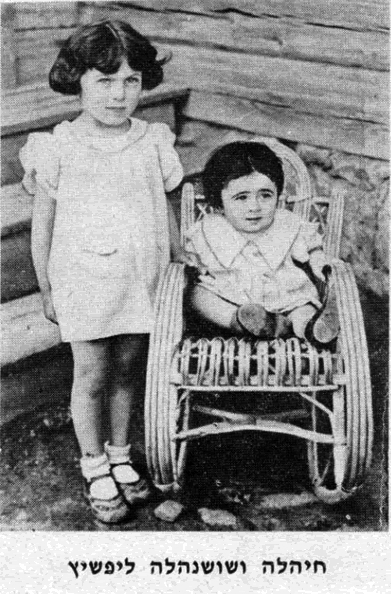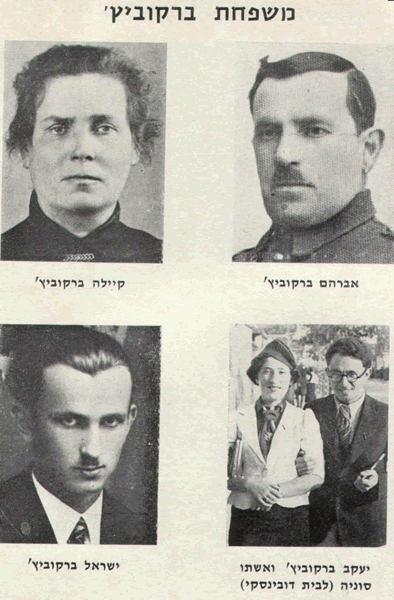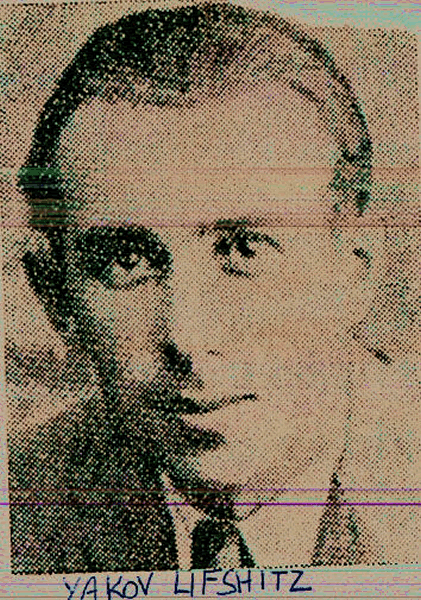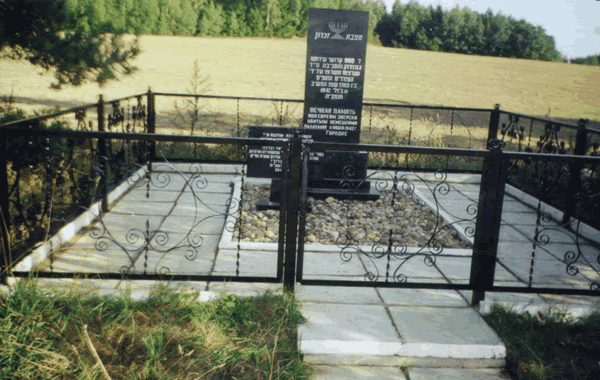| |
Radoshkovichi - Stories:
The war years story of Yakov Lifshitz and his wife; Fruma nee Shulman
Fruma was born to Alter and Fayga Shulman in Radoshkovich c 1910.
Fruma said;
In 1939, After the Soviets occupied Volozhin, I returned to town from Ivianits to teach Yiddish in the Hebrew School which was turned into a Yiddish Primary School. In 1940/41 it became a Russian School, the Polish School was turned to a Belorussian and the Polish Gymnasia (high school) to a Russian High School.
In June 1941, at the eve of the German occupation, our family lived in Leybe Berman's house.
Chayale was born in Volozhin on April 24, 1936,
and Shoshanale Lifshitz born in Volozhin on July 7, 1933.
Our girls, Shoshanele and Hayele, both born in Volozhin, we sent to my parents Alter and Fayga Shulman in Radoshkovich to pass the summer vacation. When the Nazis invaded our country, most of the Soviet citizens who lived in Western Belarus ran away towards the old border (Poland/ Soviet Union pre 1939). It was located right in the outskirts of Radoshkovich, so my husband Yakov Lifshitz and I decided follow them. We took the way to Radoshkovich by foot to join my parents and our daughters. We walked the entire night. Yakov became totally exhausted. He stopped near the shtetl. I entered Radoshkovich alone. I only met my father there.. My mother, sisters Bracha Shulman and Heina Berman and her family, brother Israel Shulman and both my daughters had run away to the hamlet Ordanka, which in normal days served as a summer resting place.
Radoshkovich was overcrowded by refugees from Poland and Lithuania. Meanwhile, my husband recovered and arrived in town. We went to Ordanka, from where we took our daughters, and continued with them on our way, this time to Horodok, where Kheyne, my elder sister, lived.
I went twice to Volozhin. I took some of the clothing we left there to exchange for food for the girls. I had the opportunity to secretly enter the well guarded ghetto through Pinches the smith's workshop, which stood near the Ghetto fence. I met there Sonia nee Dubinski Berkovitsh the daughter-in-law of my aunt Keyle nee Shulman Berkovitsh. (sister of my father Alter). They were astonished to see me. They were told that our entire family had been killed.
I returned to Horodok, where mass-slaughter survivors from Volozhin and Molodetshno just arrived. The Germans established a small concentration work camp in Krasne, a crossroad junction midway between Molodetshno and Radoshkovich, where able Jews from Volozhin, Mir, Lida, Novogrudok, Horodok and other places were brought to maintain the railroad. My husband was among them. When we separated I told him, "Our fate, mine and the girls is already determined, but you will survive because you are regarded by the German as an efficient Jew" -
So was our opinion that working for the Germans will keep us alive.
Every week some of the workers were allowed to go and bring food from Horodok into the Krasne camp.
My little six year old daughter caught a bad scurvy gums illness. Mr Ratskin the Judenrat head pitied me and arranged for Yakov a special permission to come for a visit in the Horodok ghetto.
The bitter end of the Horodok ghetto arrived at the Shabbat that Yakov spent with us, on July 11th 1942.
The Jews of Horodok and the vicinity did not sense the oncoming danger. Their last sleep had been a sleep of the just.
The next morning at an early day break hour the Gestapo and its local assistants intruded the Ghetto to take out the Jews.
Five persons lodged at our home.
There were three hiding places. The hideout in which I concealed myself with my little girls was discovered by the local police after the action had already passed.
Mr. Ratskin, who was an elderly man, could not sustain the strangling atmosphere in the small hidding place. We assumed that the action had already passed and he was obliged to go outside. His going out had provoked our disclosure of our hiding place. They shot at Yakov and killed him on the spot.
Afterward the murderers gathered all the Jews they found into the square to be selected. Those they found able to work were transferred to the Krasne camp. The old ones, invalids and children were sent to death.
Among the sentenced to die was also Fruma, Tsivya Tsart's mother. She had been beat bestially, until she was covered with blood. The Germans enclosed all of them inside a barn, shot them and burned it.
[translator's note: (as Fruma told me this evening)]
In this barn, 900 Horodok Jews found their tragic fate, along with Fruma Lifshits's mother and her five grand kids, among them Shoshanele and Hayele Lifshits. Yakov had been shot by one of their Horodok gentile neighbors. Fruma witnessed her husband's death and had seen the bestial murderers throw away his body.
I was expelled to Krasne. Heyne my older sister was enclosed in the Krasne Concentration camp, and my younger sister was placed with me in the Krasne Ghetto. There I met people from Volozhin, among them Yosef Tabakhovitsh and his wife Elke nee Shaker. Tsviya Tsart dwelled beside me and my sister on the same planks. It was impossible to safeguard any hygienic conditions, and a typhus epidemic broke out.
As a result, the three of us were hospitalized in a house outside the Ghetto. and we were "privileged" to be inspected by the Gestapo physician. He used to oversee the patients and determined by his cane movement which person to carry out to the "bath house" i.e. for execution.
After my bout with typhus I was very feeble, so Father would endanger himself by infiltrating from the camp into the ghetto to bring some grains to fortify my body.
We were brought into the "bath house". The Germans examined our withered bodies, but in some way our fate was not yet decided. Thanks to my poor health status I was released from work for a few days. I used this time to seek food for my hungry friends in the Krasne Ghetto.
Once I went to search for food with my brother in law and with Ester Rogovin from Horodok. We went into a neighboring hamlet to gather some bread. On the way back we came upon guards from the German Police. When they passed near us we distinguished red bands on the Germans forearms, they were actually Russian partisans who had fought a German unit the day before. They had won the battle, took the German uniforms and wore them. We talked to them and they agreed to take Jews who would carry arms and escape from the Krasne camp.
We returned to the Krasne camp and told everyone the exciting news. We found ways to secretly buy rifles. One day a group of us was able to cross the rails and join the partisans. They accepted us thanks to efforts made by Eliezer Rogovin from Volozhin who was already with them.. A new unit was founded by the name of "Staritski" within the Tshkalov brigade. We met some Volozhiners in the forest, among them Feygele Perski, Hirshl Rogovin, Ishayahu Lieberman and Pashe Perski wife of Simha Perski. I was transferred into a partisansâ arms repair workshop after a little time, where I worked until liberation on July 1944.
From time to time bitter fights occurred between German forces and partisan units. The hardest German attacks broke out in July 1943. During this period many partisan garrisons existed in the forests of Belarus. In order to fight them, the Germans organized the Vlassov army, named after the famous Russian traitor General Vlassov. Those units were composed of Belarus, Kazakhs, Lithuanians, Ukrainians and other anti-Semites, all of them Hooligan-murderers. Their first mission was the destruction of hamlets and farms near the forests. The fate of the peasants in those hamlets was not much better than that of the Jews. Many Christians ran to the forest. The Germans opened an offensive on the forest, by heavy shooting, shelling and setting fires. We were obliged to disperse. Kopl Kagan, Peshka Potashnik, her brothers Yehuda and Yosef, my brother-in-law Berman, and I found a hideout from which we got out just in time to meet the liberating Red Army.
Together with Peshka Potashnik we went through Krasne and Horodok into Volozhin. I decided to leave the shtetl where each stone was impregnated with blood of our dearest. The Soviet authorities proposed to me that I teach in a Belarussian school. I refused as I was not ready to teach youngsters who willingly assisted the Nazis in murdering Jews. I crossed the border to Bialostock in Poland. But here in the Land of the Jews’ extermination camps, where the A.K.(Armiya Krayova), blood thirsty anti-Semites awaited us, I could not stay.
I continued my wandering. From Bialostock I went to Lublin, and then with a Zionist refugee organization, I went through Czechoslovakia to Hungary and Romania.
After the victory in 1945 we did not want to remain in a Communist-ruled country behind the Iron Curtain. With the assistance of the Zionist Organization, we crossed the border to Austria and then went on to Italy. We passed a "Hakhshara" near Barry, and then we waited to go to the Land of Israel.
The British Government had refused to deliver the certificates permitting our entry into our Land, so we went to Israel with the Illegal Aliya. Along with 170 other Jewish refugees many of them were sole holocaust survivors of entire families.
We boarded a small boat.
I arrived in Eretz Israel on September of 1945.
Fruma's parents: Shulman, Alter and his wife, Fayga.
Their daughters (Fruma's sisters): Heina (Berman) and Bracha.
Their sons (Fruma's brothers): Hanoch (killed serving in the Polish army) and Israel
Shulman -
all perished in the holocaust.
Fruma had a brother Itskhok. He was in the States during the war.
I talked with Fruma nee Shulman. Fruma was born in Radoshkovichi about 93 years ago.
She told me that when she was growing up in Radoshkovichi there were three Shulman families in Radoshkovichi
and she is related to two of them, as both her mother and her father were born Shulmans.
Her father was Alter Shulman and her mother was the daughter of Shaya Shulman.
Her mother had uncles and brothers in Pennsylvania.
There were two brothers and two sisters of her mother,
one that she met in New York was RASHA FIDELHARP (?).
She also said she had relatives in Miami.
|
|


Clockwise: Keyla Berkovitsh nee Shulman (Fruma's aunt) ;
Avrom Berkovitsh;
Their son Yakov Berkovitsh with his wife Sonia (born Dubinski) ;
Their second son Isroel Berkovitsh |
|




